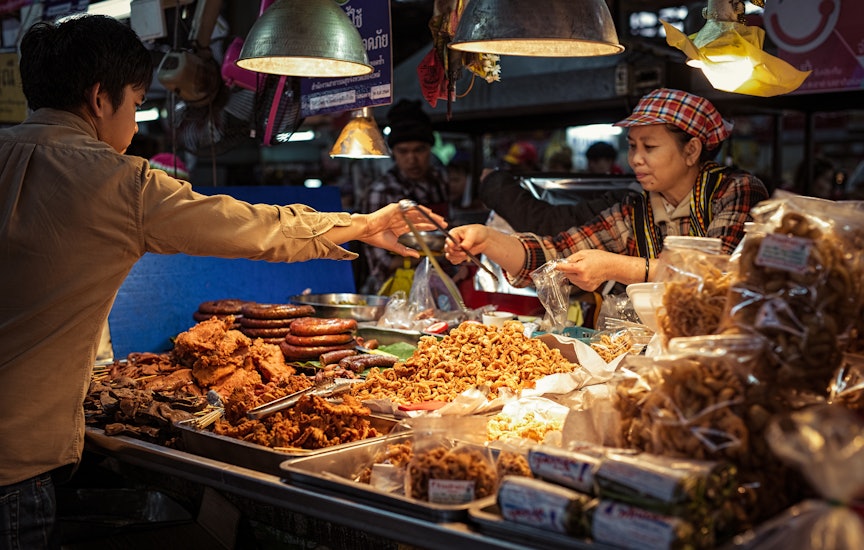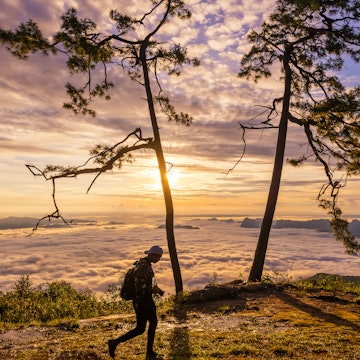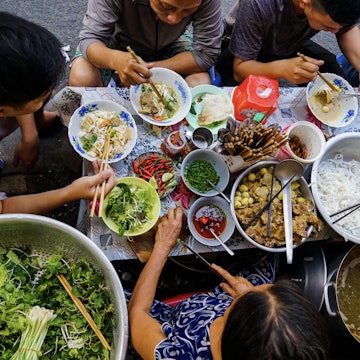

Adult and baby elephants eating sugar cane © hangingpixels / Shutterstock
Increased awareness of the harm that riding elephants can cause these remarkable animals saw Thailand’s elephant tourism industry pivot to offer "gentler" interactions. Now, amid claims by animal welfare groups that all interactive experiences can be problematic, a growing number of global tour operators no longer include them on trips. So what options are left for travelers who want to experience Thailand’s elephants responsibly post-pandemic?
The evolution of Thailand’s elephant industry addresses the growing understanding that the nation’s long history of using elephants as beasts of burden, and the reverence of elephants in Thai culture, doesn't change the harm that is done to elephants by tourism today.
The good news is that there are now alternatives to the exploitative elephant camps where elephants are forced to perform for tourists’ entertainment. Dotted around Thailand, particularly in the northern hills around Chiang Mai and Chiang Rai, are a growing number of centers for rescued working elephants that offer a chance to encounter these incredible mammals – and help to pay for their upkeep – without causing them harm. Seeing elephants up close, while not too close, is an experience you'll remember for a lifetime, particularly if you have kids in tow.

Understanding elephant welfare issues in Thailand
There was a time when you could barely turn a corner in Thailand without seeing another billboard touting elephant rides or shows with elephants painting, balancing, or performing other circus stunts. However, that's now changed due to amendments to Thai law and because tourists have started to demand better welfare for captive elephants.
Thailand has been slow to legislate for the protection of elephants, but there have been improvements. Under Thai law, elephants are still classed as "working animals", but the new legislation will compel owners of captive elephants to provide DNA samples to the national elephant database and to register all new elephant births, allowing the authorities to better monitor the welfare of Thailand's estimated 3800 working elephants.
There is still a long way to go, with a Chiang Mai University study published in 2021, for example, finding that more than half of elephants in Chiang Mai Thai tourist facilities have nervous tics that may reflect anxiety, frustration, or boredom.
A more effective lever pushing elephant camp operators to improve standards is growing consumer awareness of elephant welfare, buoyed by the campaigning of animal welfare groups such as NGO World Animal Protection, publishers of a helpful online guide to responsible elephant interactions.
Once seen as a harmless activity, riding in howdahs (elephant carriages) is now widely recognized to cause pain and spinal damage to elephants. Even "shoulder riding" – the traditional riding technique used by mahouts (traditional elephant drivers) – is now discouraged by animal welfare groups.
Then there's the issue of the methods used to train working elephants. Young elephants are typically caged, beaten, and goaded with metal bullhooks to persuade them to submit to carrying passengers or perform circus tricks. Even fully trained captive elephants are sometimes hobbled with chains to prevent them from escaping or harming tourists.

The changing face of elephant tourism in Thailand
Following tourist backlash, many elephant camps have abandoned elephant rides and shows in favor of less intrusive ways to engage with elephants, such as bathing elephants in rivers and ponds, and feeding elephants. Many camps have abandoned chains entirely, allowing captive elephants to form their own family groups, in large, open enclosures.
While this is a step forwards, some animal welfare groups encourage tourists to go further, avoiding experiences that involve direct contact with elephants because of the techniques used to train elephants to accept human interaction.
“There is still a certain element of control required for elephants to be in close contact with humans, whether it’s rides or elephant bathing,” explains Drinya Kenyon from World Animal Protection, adding that close contact with elephants also poses safety risks for tourists. “Even when elephants are under a high level of control, they can still be unpredictable.”
The global tourism industry is increasingly taking note. In 2019, ABTA, the UK’s largest travel association, updated its animal welfare guidelines to make it "unacceptable" for tour operators and travel agents (who adopt the guidelines) to offer tourists direct contact with elephants or feed elephants without a barrier.
Since 2020, Intrepid Travel has only offered trips in Thailand that help support the elephants and mahouts impacted by its 2014 decision to stop selling elephant rides. Initiatives such as these have prompted Thailand’s elephant industry to pivot once again, with a growing number of camps now transitioning to offer observation-only elephant experiences.

The impact of COVID-19 on Thailand's elephants
There's a valid argument for not supporting interactive elephant tourism, but the situation is complex. Most captive elephants are unable to return to the wild, and they need to be fed, exercised, and given medical treatment, placing a huge financial burden on their owners.
The COVID-19 pandemic has only increased the financial burden. By mid-2020, hundreds of captive elephants had been sold or abandoned, with owners unable to cover the cost of their upkeep due to the lack of tourist revenue. More than 85 elephant camps were closed, upwards of 5000 mahouts and other elephant camp staff lost their jobs, and some of the elephant centers that led the way in promoting good elephant welfare practice are now scraping by on bank loans and donations from concerned tourists.
With many of Thailand’s elephants on the brink of starvation by mid-2021, leading conservationist Jane Goodall stepped in to launch the Foodbank: Battle For Survival campaign in collaboration with Save Elephant Foundation founder Lek Chailert – a meaningful way to support elephants until travelers can visit Thailand again.
However, World Animal Protection claims the pandemic highlights another important reason to avoid direct contact with elephants, with Global Head of Wildlife Research Dr. Jan Schmidt-Burbach pointing out that “about 70% of emerging zoonotic infectious diseases originate from wild animals and being in close proximity with humans elevates the risk of infection.”
The lack of tourists during the pandemic has also demonstrated the unsustainability of breeding elephants for tourism. Seeing an end to this practice is a key goal of a new bill for elephant protection World Animal Protection is currently working on it with a team of experts.
With tourists now returning to the Thai Kingdom following its reopening to vaccinated tourists in November 2021, it's more important than ever to use your tourist dollars to support the ethical treatment of captive elephants. Here are five examples of high-welfare elephant tourism ventures, where elephants can be admired in a sanctuary-style environment – the next best thing to viewing them in the wild. For more, see World Animal Protection’s elephant-friendly list.

ChangChill, Chiang Mai
Opened in 2019 with support from World Animal Protection, ChangChill was the first elephant venue in the Chiang Mai area to fully transition from interactive elephant tourism to an observation-only model. Day visits begin with a jungle hike to observe ChangChill’s six female elephants moving around the hilly, jungle-covered property, an hour-and-a-half drive southwest of the city. In the afternoon, visitors relax on viewing platforms as the elephants socialize by a gurgling stream, with a guide on-hand to interpret their natural behavior. One-day visits including transfers from Chiang Mai and lunch cost 2500B (US$75).
Burm & Emily’s Elephant Sanctuary (BEES), Chiang Mai
After witnessing the hardships experienced by elephants working in tourist camps, Australian Emily McWilliam founded BEES with her Thai partner Burm Rinkaew in 2010. Visits to this lush sanctuary, a 2.5-hour drive southwest of central Chiang Mai, are structured like a mini-volunteering program, with lots of hiking to observe the natural behavior of elephants, in between helping out with elephant food preparation, construction tasks, planting trees, and other activities. BEES now has a "hands-off" policy, meaning visitors observe elephants but don't touch them. Costs start at 2500B (US$75) for a full-day visit with lunch (visiting with your own transport). Transfers are available for longer visits.
Boon Lott’s Elephant Sanctuary (BLES), Sukhothai
BLES was founded in 2007 by Briton, Katherine Connor, who dedicated her life to nurturing rescued and retired elephants after encountering a courageous baby elephant called Boon Lott ("survivor" in Thai). Visitors to BLES, located outside the village of Baan Tuek, an hour’s drive north of Sukhothai airport, get involved in all aspects of sanctuary life, from collecting elephant food from the jungle to maintaining herding areas and grazing grounds. Overnight visits including transfers and all meals cost 6000B (US$178). Due to its remote location, BLES does not run single-day tours – most visitors stay for several days on individually-tailored itineraries.

Following Giants, Ko Lanta
Also supported by World Animal Protection, Following Giants transitioned to an observation-only model in late 2019. On a day's visit to this lush Ko Lanta elephant venue, guests shadow elephants on a jungle walk and plant treats for the pachyderms to find while foraging. Those staying for the full-day program hike to a stunning cave and a waterfall, and share herbal drinks with the local mahouts. Full-day visits including transfers and lunch cost 3500B (US$105).
Phuket Elephant Sanctuary, Phuket
In 2020, this center for retired logging elephants in north-eastern Phuket opened Thailand’s largest canopy walkway, from which visitors can observe elephants simply being elephants. While feeding is allowed on some programs (half-day tours from 3000B (US$90)), a barrier separates elephants and visitors during the activity. A 7-day volunteering program is also available (18,000B (US$535).
What to bring when visiting an elephant center
Elephant centers tend to be in hot, humid rural areas. Wear lightweight clothing (with long sleeves/trousers for overnight visits) and bring a sunhat, sunscreen, DEET-free insect repellent, some sturdy shoes, and swimwear if there is a waterhole on the property, plus a change of clothes in case you get muddy.
Also bring drinking water, ideally filling your own bottle to avoid buying water in plastic bottles. Volunteers should expect basic facilities, usually simple accommodation blocks with mosquito nets, basic cooking facilities, Thai-style bathrooms, and (often) cold showers.
You may also like:
Thailand's best beaches from peaceful paradises to parties
The quickest, easiest and most affordable ways to get around in Thailand
Jungle safaris, kayaking and bird-spotting at Thailand's top national parks
















